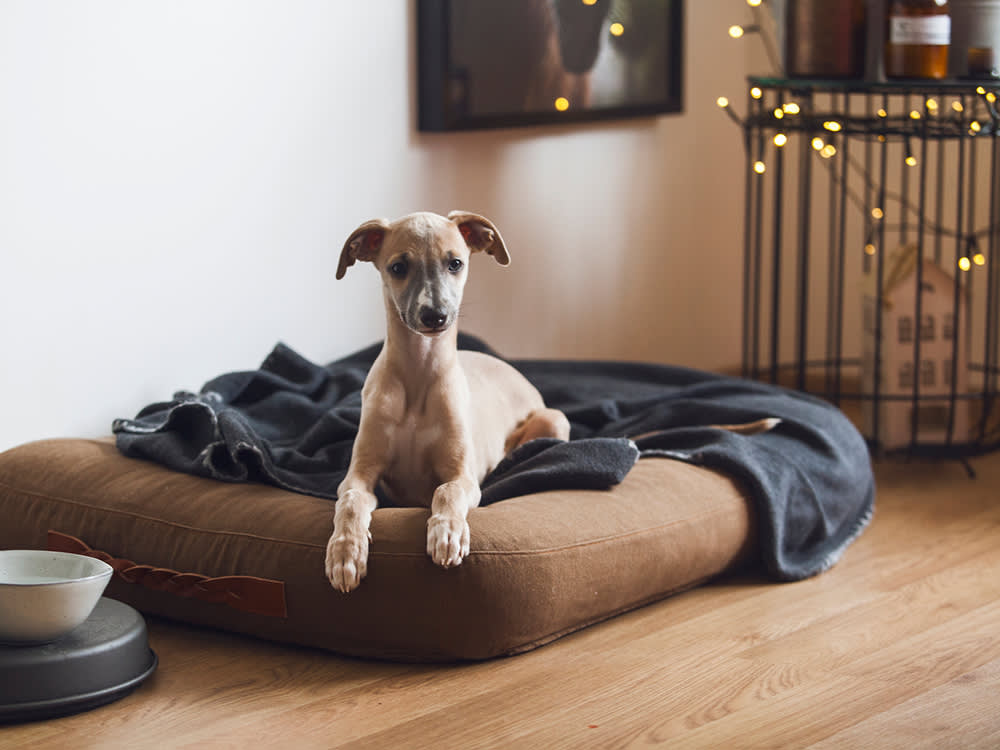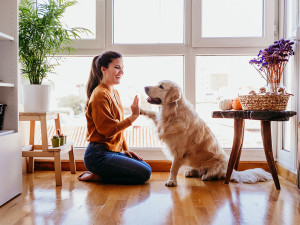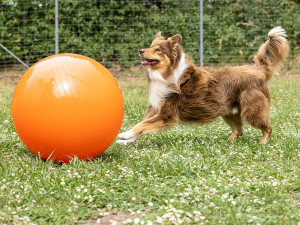Use Platform Dog Training to Elevate Your Pup’s Skills
Using platforms are favorites with pro dog trainers—here’s why you should add them to your training to-do list.

share article

Your pet wants you to read our newsletter. (Then give them a treat.)
Putting your dog on a coffee table is probably the last thing you’d consider when training your dog, but platform dog training is a foundational skill and a popular technique with dog trainers.
With platform dog training, you can teach your dog useful cuesopens in a new tab like to lie down on their bed, to sit or stand on a platform, or to stand in front of you attentively. You might use this when asking your dog to keep away from the door when visitors come in or if you’re having dinner and ask your pup to go to their place and stay in their bed. It’s convenient if you’re in a vet’s waiting room, you can ask your dog to lie down by your feet on their blanket. Training your pup with these skills provides them with something familiar and comforting.
Platform dog training might seem a bit intimidating, especially if you’re a new pet parent, but read on, and you’ll see how it can be exceptionally beneficial to your pup.
What is platform dog training?
Platform dog training, also known as stationing, is a type of cue dog trainers use when asking a dog to sit or stand still in a specific spot. The spot can be a training matopens in a new tab, a dog bed, or, as the name suggests, a platform, and you can send a dog there with a simple command. An elevated platform can be used in combination with a mat or a dog bed.
Getting started with platform dog training.
There are plenty of things around the home you can use as a dog training platform, like an old coffee table, an ottoman, a durable box, or you can buy a specific dog-training platform. What matters most is that the surface is non-slip so that way your pup doesn’t slide across it.
Many basic dog obedience tricksopens in a new tab, like stay, sit, and down, can be taught using a platform. But one of the best cues to start with when training your dog on a platform is “attention.” It might sound simple, but having your dog stand right in front of you, giving you their attentionopens in a new tab, is an essential skill. If you have a dog’s attention, you can train them to do just about anything; without it, the likelihood of teaching them much of anything is nearly zero. That’s why training your dog to give their attention by standing in front of you, looking at you, being calm, and waiting for a cue is so helpful.
When your dog is on the platform, you can reward the attention given with a high-value treat at a high rate of reinforcement. While it might seem like “they’re not even doing anything,” they are actually doing so much. The behavior isn’t flashy, but to have a dog focusing on you and eager to work is amazing and should be reinforced if you want it to occur in the future. Don’t ever take this behavior for granted.
What are the benefits of platform dog training?
Stationing on a platform is hugely beneficial in dog training. It can facilitate a calm and controlled environment, help dogs keep attention and focus, learn patience, and gives you, as the trainer, the opportunity to hit the reset button if things aren’t hitting the mark.
Focus
The main reason dog trainers love platform training is the focus and attention dogs give while in station. When dogs get used to working in a particular place like a platform, they tend to enter training mode as soon as they jump onto the platform. Their associations with these locations prepare them for what’s coming: “Okay, let’s train! What am I going to learn today?” When a dog is up on a raised surface, they are also contained to some degree, which makes training easier. They are less likely to wander off, sniff the ground or interact with anyone other than the trainer right in front of them.
Calm
Stationing allows order to emerge from chaos when working with multiple animals simultaneously. When each dog has a station, or a place to call their own, they can be kept at a distance from one another, preventing scuffles, negative interactions, or from becoming overwhelmed. Dog introductionsopens in a new tab are also easier with platforms because dogs can each be in a stable location where they can get used to each other at a distance.
Patience
Stations are also handy for teaching dogs to wait, it helps prevent them from becoming frustrated. They understand that when they are waiting to train, there is nothing they can do to earn treats. It helps them feel more relaxed than if they think they may have an opportunity.
Reset
If something goes awry in a training session—an unclear cue, a poorly timed reinforcement or other miscommunication between the trainer and the dog—it’s easy for a dog to get confused or lose some confidence. Asking a dog to go to the platform or their bed can act like an eraser for that bad moment. Stationing gives trainer and trainee a fresh start, and it is not unusual for professional dog trainers to use a quick return to the platform as a reset button.

Karen B. London, PhD, CAAB, CPDT-KA
Karen B. London, Ph.D., is a Certified Applied Animal Behaviorist and Certified Professional Dog Trainer who specializes in working with dogs with serious behavioral issues, including aggression, and has also trained other animals including cats, birds, snakes, and insects. She writes the animal column for the Arizona Daily Sun and is an Adjunct Professor in the Department of Biological Sciences at Northern Arizona University. She is the author of six books about training and behavior, including her most recent, Treat Everyone Like a Dog: How a Dog Trainer’s World View Can Improve Your Lifeopens in a new tab.
Related articles
![A woman holding a dogs paw and smiling.]() opens in a new tab
opens in a new tabNine Useful Tricks to Teach Your Dog
Go beyond the basics.
![Guy sitting with his dog at his desk at work.]() opens in a new tab
opens in a new tabHow to Train Your Dog for a Day At the Office
July 24 is National Take Your Dog to Work Day. Dog trainer Robert Haussman shares his tips for how to teach your pup to be your favorite co-worker.
![A border collie playing Treibball with an orange ball.]() opens in a new tab
opens in a new tab“Urban Herding” Can Burn Your Dog’s Energy
If your dog needs a job, trainers recommend Treibball.
- opens in a new tab
How to Train a Dog Not to Jump
The Wildest Collective dog trainer Robert Haussmann’s pro tips for getting a hyped-up dog to chill out.



